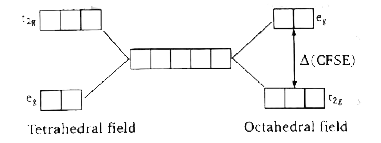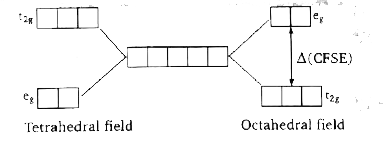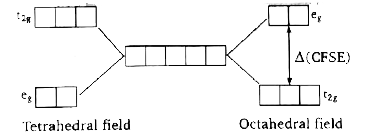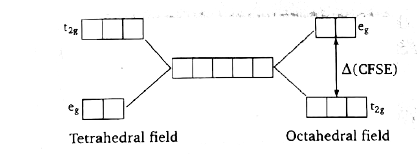When degenerate d-orbitals of an isolated atom/ion come under influence of magnetic field of ligands, the degeneracy is lost. The two sets t2g(dxy,dyz,dxz)andeg(dz2,dx2−y3) are either stabilized or destabilized depending upon the nature of magnetic field. It can be expressed diagramatically as : Value of CFS depends upon nature of ligand and a spectro-chemical series has been made experiment-ally, for tetrahedral complexes Δi is about 4/9 times to Δ0 (CFSE for octahedral complexes).
![When degenerate d-orbitals of an isolated atom/ion come under influence of magnetic field of ligands, the degeneracy is lost. The two sets t(2g)(d(xy),d(yz),d(xz))ande(g)(d(z^(2)),d(x^(2)-y^(3))) are either stabilized or destabilized depending upon the nature of magnetic field. It can be expressed diagramatically as : Value of CFS depends upon nature of ligand and a spectro-chemical series has been made experiment-ally, for tetrahedral complexes Delta(i) is about 4/9 times to Delta(0) (CFSE for octahedral complexes). The energy lies in visible region and i.e., why electronic transition t(2(g))hArre(g) are responsible for colour. Such transitions are not possible with d^(0) and d^(10) configuration. The value of CFSE (Delta(a)) for complexes given below follow the order: {:([Co(NH(3))(6)]^(3+),[Rh(NH(3))(6)]^(3+),[Ir(NH(3))(6)]^(3+)),(](https://d10lpgp6xz60nq.cloudfront.net/physics_images/AKS_TRG_AO_CHE_XII_V02_C_C06_E02_045_Q01.png)
The energy lies in visible region and i.e., why electronic transition t2g⇔eg are responsible for colour. Such transitions are not possible with d0 and d10 configuration.
The value of CFSE (Δa) for complexes given below follow the order:
[Co(NH3)6]3+[Rh(NH3)6]3+[Ir(NH3)6]3+(I)(II)(III)Solution in Telugu
I<II<III
I>II>III
I<II>III
I=II=III
The correct Answer is:A
For a given ligand and charge of metal ion, CFSE increases from top to bottom in a group.
Topper's Solved these Questions
- BOOK - AAKASH SERIESCHAPTER - CO-ORDINATION COMPOUNDSEXERCISE - LEVEL-II LECTURE SHEET EXERCISE-II (Linked Comprehension type questions ) Passage-III3videos
CO-ORDINATION COMPOUNDS
- BOOK - AAKASH SERIESCHAPTER - CO-ORDINATION COMPOUNDSEXERCISE - LEVEL-II LECTURE SHEET EXERCISE-II (Linked Comprehension type questions ) Passage-IV3videos
CO-ORDINATION COMPOUNDS
- BOOK - AAKASH SERIESCHAPTER - CO-ORDINATION COMPOUNDSEXERCISE - LEVEL-II LECTURE SHEET EXERCISE-II (Linked Comprehension type questions ) Passage-I3videos
CO-ORDINATION COMPOUNDS
- BOOK - AAKASH SERIESCHAPTER - CHEMISTRY IN EVERYDAY LIFE EXERCISE - PRACTICE SHEET - 2 (PRACTICE SHEET -2 (INTEGER ANSWER TYPE QUESTIONS))7videos
CHEMISTRY IN EVERYDAY LIFE
- BOOK - AAKASH SERIESCHAPTER - COMPLEX COMPOUNDS EXERCISE - PRACTICE EXERCISE45videos
COMPLEX COMPOUNDS
Similar Questions
Complex compounds are molecular compounds which retain their indentities even when dissolved in water. They do not give all the simple ions in solution but instead furnish complex ions. The complex compounds are often called coordination compounds because certain groups called ligands are attached to the central metal ion by coordinate or dative bonds. Coordination compounds exhibit isomerism, both structural and stereoisomerism. The struculre, magnetic property, colour and electrical properties of complexes are explained by various theories.
Arrange the following compounds in order of of their molar conductance :
i) K[Co(NO2)4(NH3)2] ii) [Cr(ONO)3(NH3)3]
iii) [Cr(NO2)(NH3)5]3[Co(NO2)6]2 iv) Mg[Cr(NO2)5(NH3)]04:46View SolutionThe central metal ion in the complex makes available a number of empty orbitals for the formation of co-ordinate bonds with suitable ligands. The inner d-orbitals or outer d-orbitals are involved. The empty hybrid orbitals of metal ion overlap with the filled orbitals of ligand to from metal ligand co-ordinate bonds. For co-ordination number 6 octahedral geometry and sp3,d2ord2sp2 hybridisation involved and for cordiantion number 4 tetrahedral geometry, square planar geometry and sp3.dsp2 hybridisation involved.
Hybridisation present in [Cr(NH3)6]+305:32View SolutionValence bond theory successfully explains the magnetic behaviour of complexes. The substances which contains unpaired electrons are paramagnetic and paramagnetic character increases as the number of unpaired electrons increases. Magnetic moment of a complex can be determined experimentally and by using formula √n(n+2) and we can determine the number of unpaired electrons in it. This information is important in writing electronic structure of complex which in turn also useful in deciding the geometry of complex.
There are four complexes of Ni. Select the complex/es which will be attracted by magnetic field.
[Ni(CN)4]2−(I) [NiCl4]2−(II) Ni(CO)4(II) [Ni(H2O)6]2+(IV)03:26View SolutionOne mole Benzene in presence of light on reaction with 'x' moles of Cl2 forms B.H.C. what is 'x' ?
04:35View SolutionThe primary and secondary valencies of the central metal ion in the complex [Co(NH3)6]Cl3 respectively are
09:14View SolutionWhen degenerate d-orbitals of an isolated atom/ion come under influence of magnetic field of ligands, the degeneray is lost. The two set t2g(dxy,dyz,dxz)andeg(dx2−dx2−y2 are either stabilized or destabilized depending upon the nature of magnetic field. it can be expressed diagrammatically as:

Value of CFSE depends upon nature of ligand and a spectrochemical series has been made experimentally, for tetrahedral complexes, Δ is about 4/9 times to Δ0 (CFSE for octahedral complex). this energy lies in visible region and i.e., why electronic transition are responsible for colour. such transition are not possible with d0andd10 configuration.
Q. The d-orbitals, which are stabillized in an octahedral magnetic field, are:View SolutionWhen degenerate d-orbitals of an isolated atom/ion come under influence of magnetic field of ligands, the degeneray is lost. The two set t2g(dxy,dyz,dxz)andeg(dx2−dx2−y2 are either stabilized or destabilized depending upon the nature of magnetic field. it can be expressed diagrammatically as:

Value of CFSE depends upon nature of ligand and a spectrochemical series has been made experimentally, for tetrahedral complexes, Δ is about 4/9 times to Δ0 (CFSE for octahedral complex). this energy lies in visible region and i.e., why electronic transition are responsible for colour. such transition are not possible with d0andd10 configuration.
Q. For an octahedral complex, which of the followin d-electron configuration will give maximum CFSE?View SolutionWhen degenerate d-orbitals of an isolated atom/ion come under influence of magnetic field of ligands, the degeneray is lost. The two set t_(2g)(d_(xy),d_(yz),d_(xz)) and e_(g) (d_(x^(2))-d_(x^(2)-y^(2)) are either stabilized or destabilized depending upon the nature of magnetic field. it can be expressed diagrammatically as: Value of CFSE depends upon nature of ligand and a spectrochemical series has been made experimentally, for tetrahedral complexes, Delta is about 4/9 times to Delta_(0) (CFSE for octahedral complex). this energy lies in visible region and i.e., why electronic transition are responsible for colour. such transition are not possible with d^(0) and d^(10) configuration. Q. Ti^(3+)(aq) . is purple while Ti^(4+)(aq) . is colourless because:
View SolutionWhen degenerate d-orbitals of an isolated atom/ion come under influence of magnetic field of ligands, the degeneray is lost. The two set t_(2g)(d_(xy),d_(yz),d_(xz)) and e_(g) (d_(x^(2))-d_(x^(2)-y^(2)) are either stabilized or destabilized depending upon the nature of magnetic field. it can be expressed diagrammatically as: Value of CFSE depends upon nature of ligand and a spectrochemical series has been made experimentally, for tetrahedral complexes, Delta is about 4/9 times to Delta_(0) (CFSE for octahedral complex). this energy lies in visible region and i.e., why electronic transition are responsible for colour. such transition are not possible with d^(0) and d^(10) configuration. Q. Which of the following is correct arrangement of ligand in terms of the Dq values of their complexes with any particularr 'hard' metal ion:
View SolutionWhen degenerate d-orbitals of an isolated atom/ion come under influence of magnetic field of ligands, the degeneray is lost. The two set t2g(dxy,dyz,dxz)andeg(dx2−dx2−y2 are either stabilized or destabilized depending upon the nature of magnetic field. it can be expressed diagrammatically as:

Value of CFSE depends upon nature of ligand and a spectrochemical series has been made experimentally, for tetrahedral complexes, Δ is about 4/9 times to Δ0 (CFSE for octahedral complex). this energy lies in visible region and i.e., why electronic transition are responsible for colour. such transition are not possible with d0andd10 configuration.
Q. The extent of crystal field splitting in octahedral complexes of the given metal with particular weak field ligand are:View SolutionWhen degenerate d-orbitals of an isolated atom/ion come under influence of magnetic field of ligands, the degeneray is lost. The two set t_(2g)(d_(xy),d_(yz),d_(xz)) and e_(g) (d_(x^(2))-d_(x^(2)-y^(2)) are either stabilized or destabilized depending upon the nature of magnetic field. it can be expressed diagrammatically as: Value of CFSE depends upon nature of ligand and a spectrochemical series has been made experimentally, for tetrahedral complexes, Delta is about 4/9 times to Delta_(0) (CFSE for octahedral complex). this energy lies in visible region and i.e., why electronic transition are responsible for colour. such transition are not possible with d^(0) and d^(10) configuration. Q. The d-orbitals, which are stabillized in an octahedral magnetic field, are:
01:44View SolutionWhen degenerate d-orbitals of an isolated atom/ion come under influence of magnetic field of ligands, the degeneray is lost. The two set t2g(dxy,dyz,dxz)andeg(dx2−dx2−y2 are either stabilized or destabilized depending upon the nature of magnetic field. it can be expressed diagrammatically as:

Value of CFSE depends upon nature of ligand and a spectrochemical series has been made experimentally, for tetrahedral complexes, Δ is about 4/9 times to Δ0 (CFSE for octahedral complex). this energy lies in visible region and i.e., why electronic transition are responsible for colour. such transition are not possible with d0andd10 configuration.
Q. For an octahedral complex, which of the followin d-electron configuration will give maximum CFSE?02:44View SolutionWhen degenerate d-orbitals of an isolated atom/ion come under influence of magnetic field of ligands, the degeneray is lost. The two set t2g(dxy,dyz,dxz)andeg(dx2−dx2−y2 are either stabilized or destabilized depending upon the nature of magnetic field. it can be expressed diagrammatically as:

Value of CFSE depends upon nature of ligand and a spectrochemical series has been made experimentally, for tetrahedral complexes, Δ is about 4/9 times to Δ0 (CFSE for octahedral complex). this energy lies in visible region and i.e., why electronic transition are responsible for colour. such transition are not possible with d0andd10 configuration.
Q. Ti3+(aq). is purple while Ti4+(aq). is colourless because:01:23View SolutionWhen degenerate d-orbitals of an isolated atom/ion come under influence of magnetic field of ligands, the degeneray is lost. The two set t2g(dxy,dyz,dxz)andeg(dx2−dx2−y2 are either stabilized or destabilized depending upon the nature of magnetic field. it can be expressed diagrammatically as:

Value of CFSE depends upon nature of ligand and a spectrochemical series has been made experimentally, for tetrahedral complexes, Δ is about 4/9 times to Δ0 (CFSE for octahedral complex). this energy lies in visible region and i.e., why electronic transition are responsible for colour. such transition are not possible with d0andd10 configuration.
Q. Which of the following is correct arrangement of ligand in terms of the Dq values of their complexes with any particularr 'hard' metal ion:03:44View SolutionWhen degenerate d-orbitals of an isolated atom/ion come under influence of magnetic field of ligands, the degeneray is lost. The two set t2g(dxy,dyz,dxz)andeg(dx2−dx2−y2 are either stabilized or destabilized depending upon the nature of magnetic field. it can be expressed diagrammatically as:

Value of CFSE depends upon nature of ligand and a spectrochemical series has been made experimentally, for tetrahedral complexes, Δ is about 4/9 times to Δ0 (CFSE for octahedral complex). this energy lies in visible region and i.e., why electronic transition are responsible for colour. such transition are not possible with d0andd10 configuration.
Q. The extent of crystal field splitting in octahedral complexes of the given metal with particular weak field ligand are:02:30View Solution

